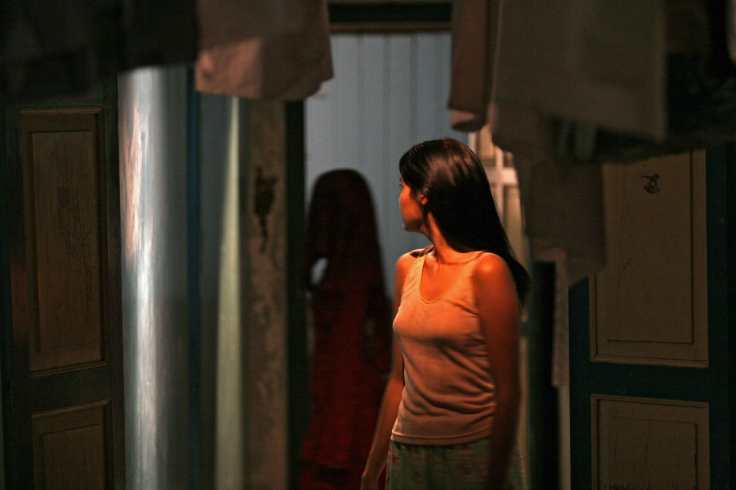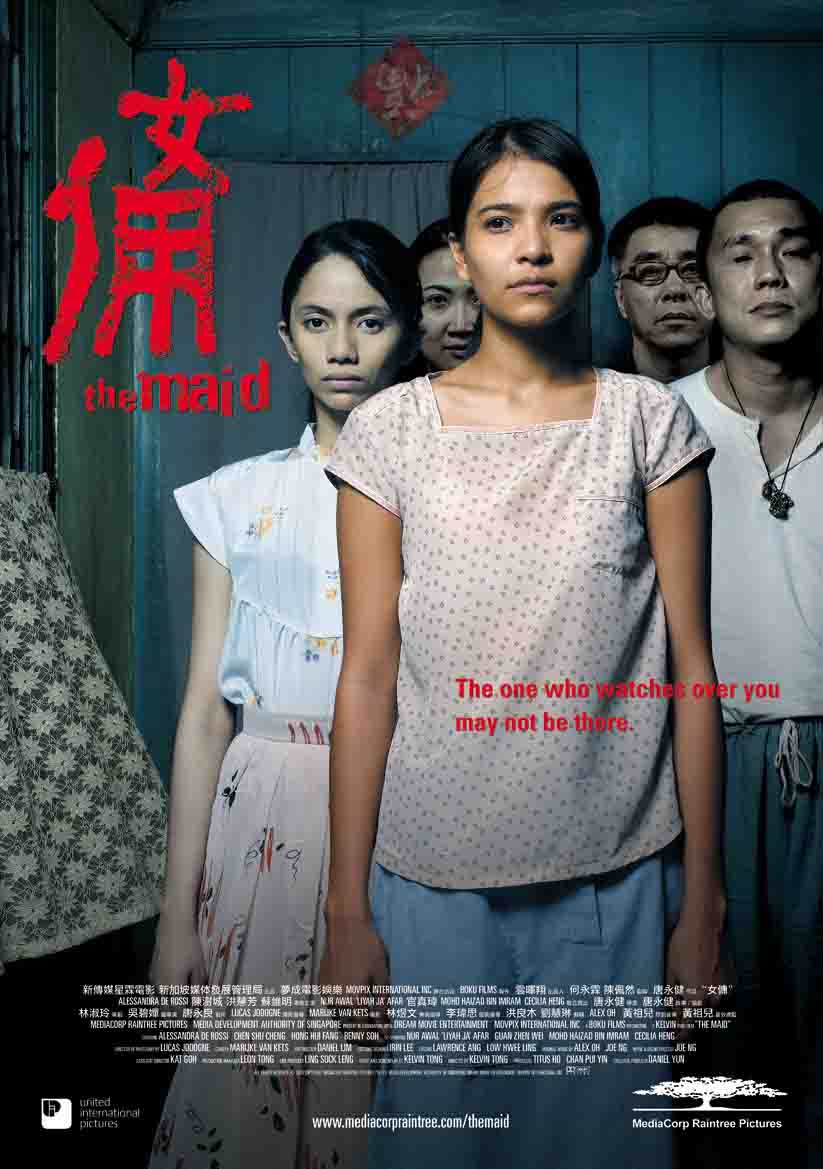Here comes my most expecting genre throughout the whole course – Asian Horror. It is not that I’m a fan or horror (do not expect to trick me into watching any horror movie); I just cannot get how it becomes such a favourite genre for many viewers! All I can see are freaking jump scares of bloody faceless ghosts and horrifying background sound effects and that’s it – no deep meaning or message.
However, I plucked up the courage to go to The Maid screening last week. It freaked me out, as usual; but thanks to this course I am forced to do some research about the genre and finally able to answer the question “Why Horror” for myself. In this blog post, I will discuss some typical traits of Asian horror and examine two elements that make the genre appealing to audience – the idea of the “beast within” and the thematic features, with a direct reference to Kelvin Tong’s The Maid.
Using folklore as driving element is a signature of Asian horror movies. “Asia is a continent that radiates mysticism and magic” and indeed “the incredibly rich and deep traditions of the continent infuse the films with an essence that can’t be found anywhere else” (Kekse, 2017). Directors of Asian horrors like to tell their country’s folklore as a way to snapshot the culture and in a manner “shock, scare or create discomfort” among spectators (Taylor, 2014).
Kelvin Tong’s The Maid is a great example. The movie premises on Singapore during the Chinese Hungry Ghost Month, a specific custom to Singaporean culture. As foreign audience is unfamiliar with this, Tong dedicates several sequences in the movie to explain the custom, especially those Buddhist restrictions including never going for a night swim, never turning around when being called in the darkness, never conversing with strangers in deserted areas, etc… I believe this mysticism plays a key role in engaging viewers, especially foreigners.
“Every year, for 30 days during the Lunar 7th month, the Chinese believe that that gates of hell are thrown open. Vengeful spirits or hungry ghosts wander among the living, seeking revenge and justice…”
– Closing credits in Kelving Tong’s “The Maid” (2005)
Moving on to answering the question “Why horror?” and how it appeals to a lot of audience, I would like to discuss the concept of “the beast within”. According to Tudor (2002), “Human beings are rotten at the core” and there is always “a beast concealed within the superficially civilized human”. Using dramatic visual and audio effects as a core, horror makes itself the best genre that can resonate with this feature of human condition.
In the beginning of The Maid, Mr and Mrs Teo appear to be loving and kind-hearted, treating Rosa as their own daughter. They teach Rosa about Singaporean culture including the Hungry Ghost Month and the Chinese street opera and show tremendous care when Rosa is terrified by the spirits. They even give Rosa early salary to send her sick brother back home in the Philippines. At first, I was struck by the Teos’ kindness and happy that Rosa could find her “family away from family”. However, in a twist, Mr and Mrs Teo turn out to be real monsters, having killed their previous maid and planning to kill Rosa in order for her to marry his dead son. Mr and Mrs Teo want to fulfill their wish of their son’s marriage so bad that they cannot tell right from wrong. They become insane and cold-blooded. Indeed, “horror appeals to deep-seated, psychoanalytically intelligible repressed desires” (Tudor, 2002).


Furthermore, I am also impressed by the movie’s ability to depict such a confronting topic of Filipino female domestic workers (FDWs) in Singapore. Horror is considered “articulations of the felt social concern”. This applies perfectly to Kelvin Tong whose reputation is for “making art-house films that depict Singaporean society and its social issues” (Taylor, 2014). As Singaporean women become increasingly involved in the workforce, housework is taken care of by FDWs coming from Asian developing countries, especially the Philippines and Indonesia (Gomes, 2011). FDWs are reported to be suppressed and encounter tension with their employers, but little notice has been paid from both sides of government and public.
Kelvin Tong dedicates The Maid to documenting the invisibility of these FDWs, who are “cut off from their loved ones, thrust into alien surroundings, expected to share a roof with strangers and then act as if everything is normal” (Tong, 2005). His use of horror genre can be interpreted as “representing the “horror” of alienation and unexpected dangers” faced by FDWs upon entering an unfamiliar country (Gomes, 2011). The Maid opens with Rosa’s youthful excitement mixed with apprehension about meeting her new employers on the way from the airport. However, as the movie unfolds, we start to feel her loneliness, anxiety and utmost fear when she rushes to the post office, having figured out the Teos’ murder. My feeling is that “The Maid” is more about generating sympathy for female domestic workers for their untold suffering and abuse.

Although The Maid is still a freaking scary movie for me, I am glad to have pulled out some underlying meanings of the movie itself and the horror genre in general. In every human-being lies the animal nature and horror is the perfect genre to document that. Much as I focus on “the beast within” idea and the thematic feature that contribute to the success of horror movies, I believe there are more than that in terms of techniques and effects. I am still a coward when it comes to horror (excuse me), but I can’t wait to spot those themes in a few more horror movies. Recommend me one! 🙂
P/s: Thank you all for following my blog during the past three months. I am by no means a good writer, but it has been a pleasure reading your comments and discussing with you about Asian Cinemas. All the best for your future path! 🙂
References:
Gomes, C 2011, ‘Maid in Singapore: representing and consuming foreign domestic workers in Singapore cinema’, Asian Ethnicity, vol.12(2), pp. 141-154
Kekse, A 2017, ‘10 best Asian horror movies you have to watch’, Moviepilot.com, viewed 18 October 2017, <https://moviepilot.com/posts/3808726>
Taylor, JT 2014, ‘‘Legend Has It … ’’: Imag(in)ing the Ethnographic Encounter in The Grudge and The Maid’, Routledge, vol. 27, pp. 117-137
Tong, K 2005, ‘The Maid’, KelvinTong.wordpress.com, viewed 14 October 2017, <https://kelvintong.wordpress.com/2005/08/18/the-maid/>
Tudor, A 2002. ‘Why horror? The peculiar pleasures of a popular genre’, Horror: The Film Reader, edited by Mark Jancovich, pp. 47-55, London: Routledge.
Feedback/Comments on others’ blog:
http://www.mediafactory.org.au/yuting-xiao/2017/10/09/blog-post-4-week-13/comment-page-1/#comment-15
https://s3588666.wordpress.com/2017/10/18/a-critical-discussion-of-snowpiercer/

Hi Duong,
I’m very interested in reading your blog. You illustrate such a thorough review on The Maid and Asian horror in general. I agree with you that I am not a fan of horror movies as well; however, since we got the chance to watch one in this course, we take time to research further about the film itself. And what I concern here is we all know that Chinese Hungry Ghost Month is a traditional folklore in Singapore and some other Asian countries, but it may cause some negative effect as it is such a superstitious behavior. So how do you think if Hungry Ghost Month should not be maintained in this modernized world?
Linh
LikeLike
Hi Linh,
Thanks for spending time to read the blog. Glad that you have the same experience 🙂
As for your question, I think Hungry Ghost Month is not just observed in Singapore but a few Asian countries as well. The notion of Hungry Ghost Month is popular in Vietnam, too. Although I don’t 100% believe in those taboos, I still take precautions as the month approaches. Just to be safe, haha.
In my opinion, it’s a cultural trait and not necessarily something bad or illegal, therefore I don’t think it should be banned or abolished in the modern world. It’s something signature of a culture that is interesting to know. However, I believe it’s better to consider that as a tradition and culture to celebrate rather than something to be superstitious about. And I think The Maid has attempted to educate the audience in that way, which is amazing.
LikeLiked by 1 person
Hi There i really enjoyed reading through your blog, i thought the way you were able to present your information on the background of the film really interesting and well laid out. When you asked the question of “Why Horror?” it really make me think of why people go and watch horror films. Maybe its because of the thrill and adrenaline, its also like say why do people go on rollercoaster rides, there are also extremely scary yet people still continue to ride them, odd right? But maybe its also because people enjoyed being scared and being able to see a fantasy reality of what the world would be like if something like this actually occurred in reality, do you think that the if western made this film what kind of approach would they take and would they use some kind mythical story or theory to base the narrative on?
LikeLike
Hi,
It’s very interesting to read your comment! Yes I agree it’s so strange that people like me are so afraid of extreme experience but still pluck up the courage to watch horror movies and go on roller coaster rides! It could be challenging at first but once you take your first ride, you can’t wait to go on more! Odd enough! 🙂
For your question, as my blog has pointed out, the use of folklore is really a signature of Asian cinemas. Asia is a continent radiates with mysticism and deep traditions, allowing folklore to be a critical driving force of movies. To my observation, Western movies are very much based on mysteries in a real life context rather than some mythical story. If Western were to make this movie, it would defo have been much different as they don’t have such folklore resources.
LikeLike